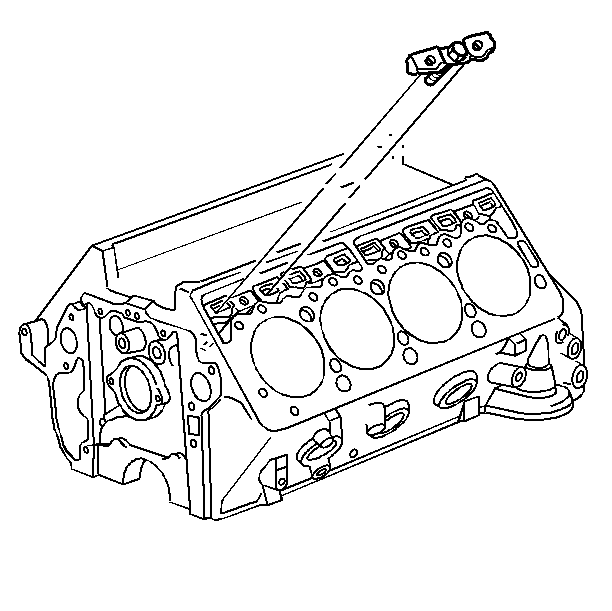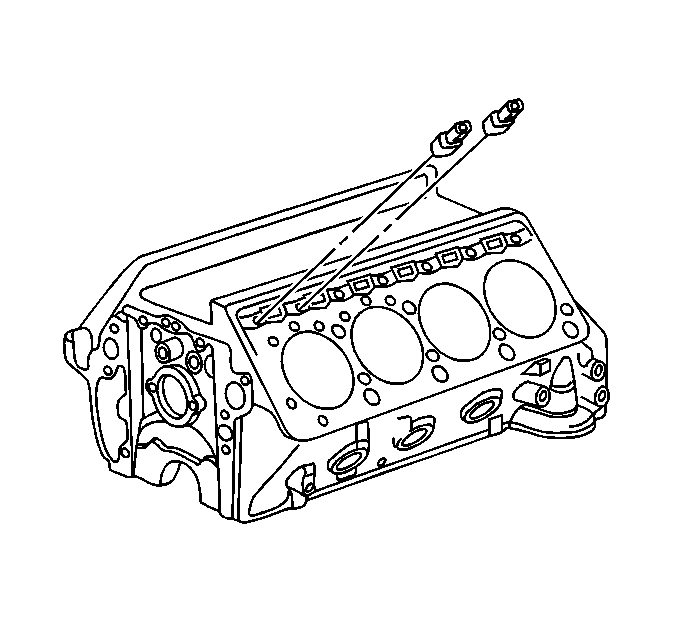Removal Procedure
- Disconnect the battery negative cables from the batteries.
- Drain the cooling system. Refer to Cooling System Draining and Filling in Engine Cooling.
- Remove the engine cover from the vehicle. Refer to Engine Cover Replacement in Body and Accessories.
- Remove the upper intake manifold from the lower intake manifold. Refer to Intake Manifold Replacement .
- Remove the lower intake manifold from the cylinder head. Refer to Intake Manifold Replacement .
- Remove the turbocharger from the engine block. Refer to Turbocharger Replacement .
- Remove the valve rocker arm cover from the cylinder head. Refer to Valve Rocker Arm Cover Replacement .
- Remove the valve rocker arm, shaft and pushrods from the cylinder head. Refer to Valve Rocker Arm, Shaft, and Push Rod Replacement .
- Remove the cylinder head from the engine block. Refer to Cylinder Head Replacement .
- Remove the retaining clamp and bolt from the engine block.
- Remove the guide plates from the engine block.
- Remove the valve lifters from the engine block.

| • | For the front battery, refer to Battery Cable Replacement in Engine Electrical. |
| • | For the auxiliary battery, refer to Battery Cable Replacement in Engine Electrical. |


Important: Some engines will have both standard and 0.010 inch oversize valve lifters. The oversize valve lifter will have a 10 etched on the side. The block will be stamped O.S. on the cast pad adjacent to the valve lifter bore and on the top rail of the cylinder case above the valve lifter bore.
| • | Place the valve lifters in an organizer rack. |
| • | The valve lifters must be installed in the same bores from which they were removed. |
Installation Procedure
Notice: Prime the new valve lifters before installation. The valve lifters may be damaged if the valve lifters are dry when the engine is started.
- Install the valve lifters into the engine block.
- Install the guide plates in the engine block.
- Install the valve lifter retainer and bolt in the engine block.
- Install the cylinder head to the engine block. Refer to Cylinder Head Replacement .
- Install the valve rocker arm, shaft and pushrods in the valve lifters. Refer to Valve Rocker Arm, Shaft, and Push Rod Replacement .
- Install the valve rocker arm cover to the cylinder head. Refer to Valve Rocker Arm Cover Replacement .
- Remove the turbocharger from the engine block. Refer to Turbocharger Replacement .
- Install the lower intake manifold to the cylinder head. Refer to Intake Manifold Replacement .
- Install the upper intake manifold to the turbocharger. Refer to Intake Manifold Replacement .
- Refill the cooling system. Refer to Cooling System Draining and Filling in Engine Cooling.
- Change the oil filter and oil. Refer to Engine Oil and Oil Filter Replacement .
- Connect the battery negative cables to the batteries.

Important: The valve lifters must be installed in their original locations.

Important: The straight edge of the guide plates and clamps face away from the cylinder.

Important: After all the clamps are installed, turn the crankshaft by hand two full revolutions, to ensure free movement of the valve lifters in the plate. If the engine will not turn over by hand, one or more of the valve lifters may be binding in the plate.
Notice: Use the correct fastener in the correct location. Replacement fasteners must be the correct part number for that application. Fasteners requiring replacement or fasteners requiring the use of thread locking compound or sealant are identified in the service procedure. Do not use paints, lubricants, or corrosion inhibitors on fasteners or fastener joint surfaces unless specified. These coatings affect fastener torque and joint clamping force and may damage the fastener. Use the correct tightening sequence and specifications when installing fasteners in order to avoid damage to parts and systems.
Tighten
Tighten the clamp bolt to 26 N·m (18 lb ft).
| • | For the front battery, refer to Battery Cable Replacement in Engine Electrical. |
| • | For the auxiliary battery, refer to Battery Cable Replacement in Engine Electrical. |
